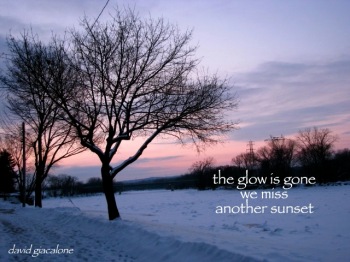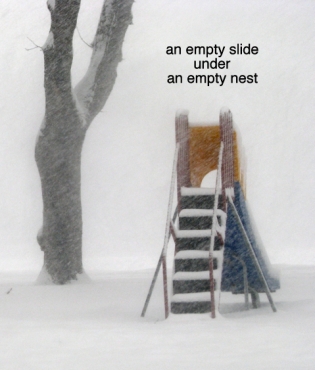 This Page contains each of the 37 “haiga” images published in the 24-page photo-book “Haiga on the Mohawk“, with photography and text by this website’s proprietor, David Giacalone (pub. September 2015, 8″ x 8”). It was created to celebrate Haiku North America 2015, a Conference presented at Union College, in Schenectady, New York, October 14-18, 2015.
This Page contains each of the 37 “haiga” images published in the 24-page photo-book “Haiga on the Mohawk“, with photography and text by this website’s proprietor, David Giacalone (pub. September 2015, 8″ x 8”). It was created to celebrate Haiku North America 2015, a Conference presented at Union College, in Schenectady, New York, October 14-18, 2015.
Photo haiga are a modern form of a Japanese artistic genre that was originally composed of an ink-brush-painted image “linked” (conceptually, often by juxtaposition or analogy) to a haiku or similar short poem rendered in calligraphy alongside the image. Haiga on the Mohawk has haiku poems linked with photographic scenes from the Mohawk River and the Schenectady Stockade Historic District. [go to this Comment, for a brief description of haiku poetry, which is not merely the simplistic verse of 5-7-5 syllables per line we were all taught in grade school] You can view the entire photo-book at Shutterfly, including captions noting the various locations, at no charge. [Shutterfly’s regular prices are high; if you would like a copy of Mohawk Haiga, contact me, and I will provide it at my cost, using available discounts.]
All photos are by David Giacalone, as are all poems, except for four (as indicated, on pages 22 – 24) which were written by the members of the acclaimed Route Nine Haiku Group.
NOTES
- For a LARGER VERSION of a haiga image below, click on the image.
- COPYRIGHT POLICY – our Creative Commons “Attribution-Non-Commercial-Share-Alike” policy is described near the bottom of our About page. Basically, you may copy and use the content for any non-commercial purpose, with proper attribution. Other uses require permission. Go here for full details.
– back cover (click on it for larger version) –
. . . and, now, the haiga . . .
From the Front Cover:
.
from the Title Page:
- moments later the above heron took flight – click here for a photo –
.
. from Page Two
.
. from Page Three:
.
from page Four:
.
.
.
from Page Five:
. .
.
.
.from Page Six:
.
.
.
. from Page Seven:
.
.
.from Page Eight:
.
.
.
.
.from Page Ten:
.
.
.from Page Eleven:
.
.
.from Page Twelve:
.
.
.
.from Page Thirteen:
.
.
.from Page Fourteen:
.
.from Page Fifteen:
.
.from Page Sixteen:
.
.
.from Page Seventeen:
.
from Page Eighteen:
.
– click this collage for a much larger version –
.
.from Page Nineteen:
.
.
.from Page Twenty:
MAKE YOUR OWN HAIGA [MYOH]:
Use one or both of the two following images to make a haiga of your own. You can share it with us by leaving a Comment.*
.MYOH photo #1
.
.MYOH photo #2
*/ At the bottom of this posting you will find an MYOH Sampler (click on each for a larger version):
.
.from Page Twenty-One:

.
from Page Twenty-two:
COLLABORATION BONUS
Haiga with poems by the Route Nine Haiku Group:
.
- above: poem by Hilary Tann
.
from Page Twenty-three:
- above: poem by John Stevenson
.
- above: poem by Tom Clausen
.
from Page Twenty-four::
- above: poem by Yu Chang
.
on the Back Cover:
.
Make Your Own Haiga
MYOH SAMPLER (click on the haiga for a larger version):
.
. . .









































 . . .
. . . 


lovely haiga David!
here is my MAKE YOUR OWN HAIGA (second image)
snowdrift
i climb the tree
of memory
By: robertabeary on September 24, 2015
at 6:25 pm
Thank you and hello, Roberta, a/k/a shortpoems! Just like old times having you stop by with a kind word and a ku. Thank you for giving the Make Your Own Haiga cue a distinguished beginning. See you soon here in Old Dorp.
By: David Giacalone on September 24, 2015
at 7:20 pm
Hi David, I would also like to contribute to “Make your own haiga”. I’m drawn to the second image.
snowfall
the track of his razor
through foam
in regards to your own collection of haiga….as a tall woman, I love your “group photo/ the tall girl stands/ even taller”
with thanks for your gorgeous photos of the region. Can’t wait to see it for myself! Really looking forward to HNA 2015! Terry Ann Carter, Victoria, British Columbia, Canada
By: Terry Ann Carter on September 27, 2015
at 3:11 pm
Hi David, I really enjoyed the Ginko Walk of the Stockade Historic District,
and the neighborhood restaurant was also a real delight. Here is a haiku
that I was writing in my head about the experience.
walking tour
the smooth cobblestones
on cucumber alley
Best regards and see you in Santa Fe,
Meik Blöttenberger
By: Meik Blöttenberger on October 21, 2015
at 1:21 pm
Hello, Meik. Thanks for your kinds words. I’m sitting at my desk trying to imagine where there are cobblestones on Cucumber Alley. But, not knowing fits nicely into the History of the Alley and the Stockade. Best wishes.
By: David Giacalone on October 21, 2015
at 1:34 pm
Hello David, I’m haunted by that image of the two snowmen left to guard the stockade the night of the massacre. Thank you for the stories from history – I found them fascinating. The river was beautiful and its name called up history too. Absence was as powerful as presence in the stockade district.
heron flying low
over the Mohawk river
wing not drum beats
By: Mary di Michele on October 22, 2015
at 10:07 am
Good morning, Mary. Thank you for joining our Ginko and leaving the evocative haiku and spot-on Stockade insight. Click on this thumbnail,

to see the blue heron flying low over the Mohawk just after I snapped the bird on its branch.
By: David Giacalone on October 22, 2015
at 10:35 am
what is haiku?
The haiku genre of poetry is often misunderstood. Despite what your grammar school teacher might have taught you, the consensus among English-language haiku poets, journals and associations is that haiku need not be written in three lines having 5, 7 and 5 syllables per line. Equally important, despite the so-called “haiku contests” you may see in the media or on the web, verse written in the form of three lines having 5, 7 and 5 syllables per line is not haiku unless it conforms to the basic characteristics of the genre. Definitions are tricky and evolving, but here is my attempt at quick definitions of haiku and the related form senryu, which are used in my photo-haiga. [for more on this topic, go here]
Quick Definition of Haiku: English-language Haiku is a very short poem (no more than 17 syllables, but the best in English often have fewer), traditionally written on three lines, that relates nature to human nature and usually compares or contrasts a pair of sensory images, which are separated by a pause (pivot). At its best, haiku lets the reader share in the poet’s “haiku moment” — a moment of insight or awe.
Quick Definition of Senryu: Senryu is a short poem similar in structure to haiku but featuring observations on human nature (often ironic, humorous and/or coarse).
By: David Giacalone on November 24, 2015
at 12:06 pm
Thankk you for sharing this
By: Miles Riley on February 8, 2023
at 2:11 am
Thank you for your kind words and for the opportunity to learn about your photo site.
By: David Giacalone on February 10, 2023
at 11:00 am